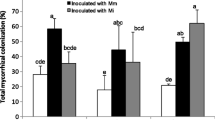Abstract
Factors influencing the sprouting ability of rhizome pieces of Calystegia sepium and root pieces of Convolvulus arvensis were analyzed in four experiments. In the first experiment, sprouting was investigated as a function of bud number. About half of the rhizome and root pieces with one bud could sprout. Almost all pieces with 6 or more buds sprouted. Mostly several buds sprouted in longer rhizome and root pieces. In the second experiment, sprouting of rhizomes and roots was measured in dependence of burial depth in the soil. With increasing depth, the sprouting ability of about 10 cm long rhizome and root pieces decreased. From deeper than 35 cm for C. sepium and 30 cm for C. arvensis no new shoots emerged. This shows that common shallow tillage practices are mostly not sufficient to suppress vegetative regeneration of these two weed species. In the third experiment, rhizome and root pieces were collected in the field and their sprouting ability was examined in the greenhouse over the season. Rhizomes of C. sepium and the roots of C. arvensis were dormant in the winter and sprouting was highest in April and May. In the fourth trial, seasonal changes of sugar concentrations were studied in the rhizomes and roots. It was found that concentrations of fructose, glucose and saccharose were highest and starch rates were lowest in mid-June for both species. We assume that this time corresponds to the optimum time for herbicide translocation in the roots/rhizomes.
Similar content being viewed by others
References
Anderson JV, Horvath DP & Chao WS & Foley ME, 2010. Bud dormancy in perennial plants: A mechanism for survival. Top Curr Genet 21, 69–90.
Baumann C & Großfeld J, 1917. Die polarimetrische Bestimmung der Stärke bei Gegenwart sonstiger optisch aktiver Stoffe. Z Untersuchung der Nahrungs- und Genußmittel 33, 97–103.
Boldt PE, Rosenthal SS & Srinivasan R, 1998. Distribution of field bindweed and hedge bindweed in the USA. J Prod Agric 11, 377–381.
Callihan RH, Eberlein CV, McCaffrey JP & Thill DC, 1990.Field bindweed: Biology and management. University of Idaho, Cooperative Extension System, College of Agriculture Bulletin 719.
Frazier JC, 1943. Food reserve depletion and synthesis in field bindweed, Convolvulus arvensis L., as related to 7-day and 14-day intervals of cultivation. Plant Physiol 18, 315–323.
Gutjahr C, Sökefeld M & Gerhards R, 2012. Evaluation of two patch spraying systems in winter wheat and maize. Weed Res 52, 510–519.
Hakansson S, 2003. Weeds and weed management on arable land — an ecological approach. CABI publishing, Uppsala, Sweden, 167.
Hess M, Barralis G, Bleiholder H, Buhr L, Eggers T, Hack H & Stauss R, 1997. Use of the extended BBCH-scale — general for the description of the growth stages of mono- and dicotyledonous weed species. Weed Res 37, 433–441.
Kleinsteuber A, Lange D, Seybold S & Philippi G, 1996. Convolvulaceae Bd.5, Spezieller Teil (Spermatophyta, Unterklasse Asteridae). In: Die Farn- und Blütenpflanzen Baden-Württembergs. O Sebald, G Philippi, S Seybold, A Wörz (eds.), Ulmer Verlag, Stuttgart, 62–64.
Knezevic M, Ranogajec L & Samota D, 2008. Effects of soil tillage and herbicides on weeds and winter wheat yields. Available at: http://bib.irb.hr/datoteka/338649.HKneevi_et_al._Effects_of_tillage_and_herbicides_on_weeds_and_winter_wheat_yields.pdf (last accessed 5 Jan. 2013).
Liew J, Andersson L, Boström U, Forkman J, Hakman I & Magnuski E, 2012. Influence of photoperiod and temperature on sprouting capacity of Cirsium arvense and Sonchus arvensis root buds. Weed Res 52, 449–457.
Mehrtens J, Schulte M & Hurle K, 2005. Unkrautflora in Mais. Gesunde Pflanz 57, 206–218.
Morishita DV, Callihan RH & Eberlein CV, 2005. Field bindweed Convolvulus arvensis L.: Convolvulaceae. Available at: http://www.cals.uidaho.edu/edComm/pdf/pnw/pnw0580.pdf (last accessed 5 Jan. 2013).
Munz PA & Keck DD, 1959. A California Flora. University of California Press, Berkeley, CA, 463.
Neubauer HF, 1988. Die Ausläufertriebe von Calystegia sepium (L.) R. Br. (Convolvulaceae). Angew Bot 62, 221–224.
Parsons WT & Cuthbertson EG, 2001. Noxious weeds of Australia. 2nd edition, CSIRO Publishing, Collingwood, Victoria, 398
Pfirter HA, Ammon H-U, Guntli D, Greaves MP & Défago G, 1997. Towards the management of field bindweed (Convolvulus arvensis) and hedge bindweed (Calystegia sepium) with fungal pathogens and cover crops. Integrated Pest Manage Rev 2, 61–69.
Rask AM & Andreasen C, 2007. Influence of mechanical rhizome cutting, rhizome drying and burial at different developmental stages on the regrowth of Calystegia sepium. Weed Res 47, 84–93.
Rusu T, Gus P, Bogdan I, Laura P & Oroian I, 2006. Researches regarding to control species Convolvulus arvensis L. on relation with soil tillage systems. J Cent Eur Agric 7, 739–742.
Schroeder D, Mueller -Schaerer H & Stinson CS, 1993. A European weed survey in 10 major cropping systems to identify targets for biological control. Weed Res 33, 449–458.
Streit B, Rieger SB, Stamp P & Richner W, 2002. The effect of tillage intensity and time of herbicide application on weed communities and populations in maize in central Europe. Agr Ecosyst Environ 92, 211–224.
Vengris J, 1962. The effect of rhizome length and depth of planting on the mechanical and chemical control of quack-grass. Weeds 10, 71–74.
Walsh NG & Entwhisle TJ, 1999. Flora of Victoria 4. Dicotyledons Cornaceae to Asteraceae, Inkata Press, Melbourne.
Wiese AF & Phillips WM, 1976. Field bindweed. Weeds Today 6, 22–23.
Wiese AF & Lavake DE, 1986. Control of field bindweed (Convolvulus arvensis) with postemergence herbicides. Weed Sci 34, 77–80.
Zwerger P & Ammon HU, 2002. Unkraut: Ökologie und Bekämpfung. Ulmer, Heidelberg.
Author information
Authors and Affiliations
Corresponding author
Rights and permissions
About this article
Cite this article
Willeke, L., Krähmer, H., Claupein, W. et al. Sprouting Ability and Seasonal Changes of Sugar Concentrations in Rhizomes of Calystegia sepium and Roots of Convolvulus arvensis. J Plant Dis Prot 122, 133–140 (2015). https://doi.org/10.1007/BF03356542
Received:
Accepted:
Published:
Issue Date:
DOI: https://doi.org/10.1007/BF03356542



